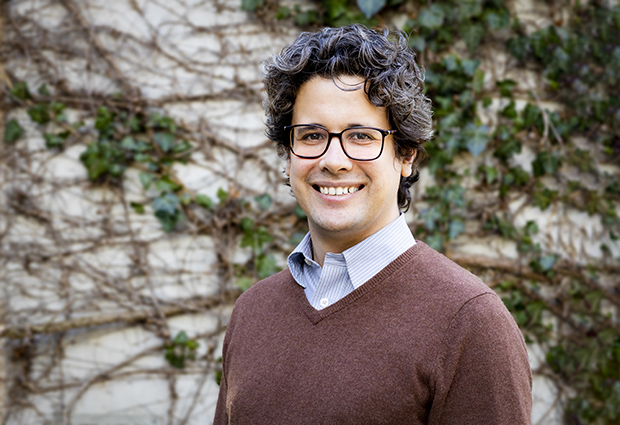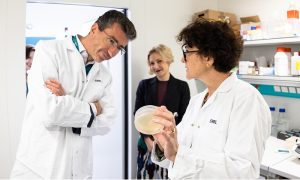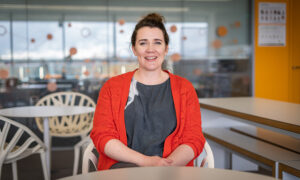
Welcome: Santiago Rompani
New EMBL group leader explores what neurobiology can teach us about what it means to be human

Santiago Rompani’s group at EMBL Rome studies the function of visual circuits in the thalamus – a part of the brain involved in relaying sensory signals from our outermost sensory organs like eyes and ears to other brain regions for processing. They investigate how the thalamus takes visual information and converts it to more sophisticated information that can be used to shape behaviour.
Could you describe your research in a nutshell?
We study the visual system, in particular how the early stages of vision can dramatically impact how we see the world. The visual thalamus, which receives direct input from the eye, had been thought of as a very simple relay nucleus, not doing very much, just passing on information to the visual cortex. However, we found that the visual thalamus is much more sophisticated than that, and we study how different internal states and senses can change vision in a very fundamental way inside the thalamus.
What question are you focusing on right now?
There’s a key question that came up from my previous work. We found that a single cell in the thalamus can get input from a variety of different cell types in the retina. We’re trying to uncover whether that means vision is being switched between a variety of different states or if they’re being combined in ways which we didn’t appreciate before. There are many open questions regarding this idea and we have some very interesting models and experiments tackling this particular complexity.
What first drew you to neuroscience and vision?
I was fascinated by the concept of neuroscience as a way of fully understanding what it means to be human. Humans are very visual creatures: so much of our brain has evolved to process visual information and is tied into how we see the world. I believe understanding this at the level of brain circuitry will really help us understand the fundamental computations that make us human.
Did you bring a team with you or did you build it at EMBL?
I was a postdoctoral fellow before, so I built my team entirely at EMBL. I made use of the very robust and high-level PhD programme here to get two PhD students, and we were able to recruit a very talented lab manager in order to really get the lab running early.
What kind of characteristics do you look for in potential PhD students?
I have three, and only three, criteria. The first is, are they smart? By this I mean general cleverness, rather than particular knowledge or background. The second is, are they motivated? The third is temperament. Do they fit in well with the group? Are they calm and collected?
Does your research require interdisciplinary collaborations?
Oh, very much so! Neuroscience is becoming increasingly interconnected and interdisciplinary. We’ll need people who are very much into computational neuroscience to make models of vision based on our experiments with optogenetics and calcium imaging. We’ll also need to collaborate with people who work with machine vision in a variety of areas, like analysing electron microscopy data. These are just a few of the many collaborations that we are actively starting.
Any advice for young scientists?
A very important part of interdisciplinary work is that it can only be effective if you’re very strong in your core discipline. Above all, you have to have a great fundamental skill set. PhD students should keep this in mind and really focus on building their core skillset during their PhD. A lot of people often overlook this key point.
You should also focus on finding the right lab for you. Try to choose projects that will help you learn the most, not just the ones that will generate the most publications, though that is an important factor, of course. Especially in neuroscience, but I think in other fields as well, learning programming will be essential too.
How long does it take between the inception of a research idea and the finished manuscript?
That’s a very important question and the most important moment is when you find that one, key piece of data. That core finding which everything else rests upon. That one kernel of, “This is cool!” You realise at that point you have a real project. You have a paper, you just need to add the accessories to it. The ideal project is the one where you get that core finding as early as possible.
So, do you work on multiple projects at a time and then focus on one when you have a key breakthrough?
Yes, if you work on multiple projects, which is advisable, the moment you get that core finding in one of them, you drop the vast majority of the others. Go crazy with your side projects at the beginning but as soon as you have something concrete in one of them, buckle down and grab on for dear life!
Do you find it easy to balance work and life in the middle of a project?
The short answer is no. There are fluctuations where sometimes you have to dedicate more or less time. Sometimes you’re working through an experiment where your mind can be more relaxed, and sometimes you’re working on a manuscript, which is much more intellectually involved.
It would be nice if science were able to have more 9-to-5 positions available. Given their current scarcity, there are challenges. If you want the 9-to-5, it can actually be far more competitive, so it depends on where you want your stress to be. Would you prefer to work really hard and have a much easier time finding a very rewarding job? Or would you prefer to have your 9-to-5 and more time for your family and hobbies? In that case, your output is not as great and suddenly you’re competing against a lot more people who have the same profile that you do. My particular choice was to focus on doing great science and I found that, if you do that, everything else will work out.


